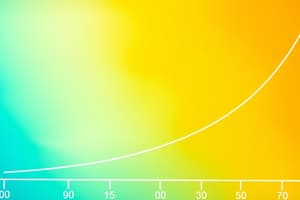Podcast
Questions and Answers
What is the pKa range of the carboxyl group in alanine?
What is the pKa range of the carboxyl group in alanine?
- 3.5 – 4.0
- 8.8 – 11.0
- 5.0 – 7.0
- 1.8 – 2.4 (correct)
What occurs at the half-equivalence point of the titration curve of alanine?
What occurs at the half-equivalence point of the titration curve of alanine?
- Half of the COOH is converted to COO¯. (correct)
- All of the COOH is neutralized.
- The amino acid has no net charge.
- The amino acid is fully protonated.
What happens to the amino acid as more base is added?
What happens to the amino acid as more base is added?
- The amino acid becomes fully protonated.
- The amino group loses its proton.
- More of the COOH is neutralized. (correct)
- The amino acid converts to a full zwitterion form.
What role does Ser 195 play in the enzyme mechanism described?
What role does Ser 195 play in the enzyme mechanism described?
What charge does the amino acid have at an isoelectric point?
What charge does the amino acid have at an isoelectric point?
Which amino acid stabilizes the positive charge of His in the enzyme mechanism?
Which amino acid stabilizes the positive charge of His in the enzyme mechanism?
What is the function of water in the enzyme mechanism described?
What is the function of water in the enzyme mechanism described?
What is the pKa value used to calculate the isoelectric point (pI) of alanine?
What is the pKa value used to calculate the isoelectric point (pI) of alanine?
What titration point occurs at the equivalence point in the curve of alanine?
What titration point occurs at the equivalence point in the curve of alanine?
Why does the product leave the enzyme in the described mechanism?
Why does the product leave the enzyme in the described mechanism?
In enzyme kinetics, what is one fundamental condition studied?
In enzyme kinetics, what is one fundamental condition studied?
How is enzyme kinetics useful in studying enzyme mechanisms?
How is enzyme kinetics useful in studying enzyme mechanisms?
What happens to the proper orientation of substrate molecules in a reaction without an enzyme?
What happens to the proper orientation of substrate molecules in a reaction without an enzyme?
What is the purpose of the activation energy barrier in a chemical reaction?
What is the purpose of the activation energy barrier in a chemical reaction?
What is the function of enzymes in reducing the activation energy of a reaction?
What is the function of enzymes in reducing the activation energy of a reaction?
Why is it impractical to increase the energy of substrate molecules by heating them up?
Why is it impractical to increase the energy of substrate molecules by heating them up?
What defines the rate of a reaction according to the text?
What defines the rate of a reaction according to the text?
What chemical species exists at the top of the energy barrier in a reaction?
What chemical species exists at the top of the energy barrier in a reaction?
What happens if the enzyme is not made in a metabolic pathway?
What happens if the enzyme is not made in a metabolic pathway?
What is one drawback to the long-term method of enzyme regulation?
What is one drawback to the long-term method of enzyme regulation?
Why is it not necessary to regulate every enzyme in a metabolic pathway?
Why is it not necessary to regulate every enzyme in a metabolic pathway?
Which method of regulation involves the non-covalent binding of an effector or modulator to change enzyme activity?
Which method of regulation involves the non-covalent binding of an effector or modulator to change enzyme activity?
When levels of the end product X are high, what happens to enzyme 1 in the pathway provided?
When levels of the end product X are high, what happens to enzyme 1 in the pathway provided?
What is the purpose of enzyme 1 being often an allosteric enzyme inhibited by the end product X in the metabolic pathway provided?
What is the purpose of enzyme 1 being often an allosteric enzyme inhibited by the end product X in the metabolic pathway provided?
What creates a mixture of products and limits the usefulness of the Ruff degradation and Kiliani-Fischer synthesis?
What creates a mixture of products and limits the usefulness of the Ruff degradation and Kiliani-Fischer synthesis?
What unusual property is exhibited by aldoses that distinguishes them from normal aldehydes?
What unusual property is exhibited by aldoses that distinguishes them from normal aldehydes?
In D-glucose, which of the following is true regarding its specific rotations in different forms?
In D-glucose, which of the following is true regarding its specific rotations in different forms?
Which process can shorten an aldose by one carbon?
Which process can shorten an aldose by one carbon?
What occurs slowly with monosaccharides during the Kiliani-Fischer synthesis compared to normal aldehydes?
What occurs slowly with monosaccharides during the Kiliani-Fischer synthesis compared to normal aldehydes?
How could a base impact the structure of a monosaccharide?
How could a base impact the structure of a monosaccharide?
Study Notes
Enzyme Function
- Without an enzyme, proper orientation of substrate molecules during collisions is a matter of chance, resulting in a low reaction rate.
- Enzymes ensure that all substrate molecules are properly oriented, increasing the reaction rate.
Activation Energy
- An energy barrier, known as activation energy, exists between substrate and product energy levels in a chemical reaction.
- The activation energy barrier must be overcome for the reaction to take place.
- A high activation energy results in a slow reaction rate, as few substrate molecules have enough energy to react.
- Enzymes can lower the activation energy, increasing the reaction rate.
Enzyme Regulation
- Enzyme activity can be regulated through the control of enzyme production or the control of existing enzyme molecules.
- Regulating the first enzyme in a metabolic pathway can turn the entire pathway on or off as needed.
- Allosteric enzymes have their activity changed through the non-covalent binding of an effector or modulator.
Monosaccharides
- Monosaccharides can be interconverted using several different reactions, such as epimerization and the Ruff degradation.
- Certain properties of monosaccharides, such as the addition of HCN and the Schiff test, are inconsistent with the presence of a normal carbonyl group.
- D-glucose can exist in two forms with different specific rotations, known as the α-form and β-form, which can undergo mutarotation.
Enzyme Mechanism
- The active site of an enzyme, such as chymotrypsin, uses acid/base catalysis and forms a covalent intermediate.
- The active site is more complementary to the tetrahedral transition state than to the original substrate.
Enzyme Kinetics
- Enzyme kinetics studies the rate of a reaction in response to changing reaction conditions, such as substrate concentration.
- The rate of the reaction can be monitored by tracking the appearance of the product or the disappearance of the substrate.
Amino Acid Properties
- Amino acids have a zwitterion form, with a carboxyl group (pKa 1.8-2.4) and an amino group (pKa 8.8-11.0).
- The form(s) of the amino acid present depends on the pH, with a fully protonated form at very low pH and a fully deprotonated form at high pH.
- The isoelectric point or isoionic point (pI) is the pH at which the amino acid has no net charge.
Studying That Suits You
Use AI to generate personalized quizzes and flashcards to suit your learning preferences.
Description
This quiz explores the titration curve of an amino acid using alanine as an example. It covers the pKa values of the carboxyl and amino groups, as well as the different forms of the amino acid present at specific pH values.




